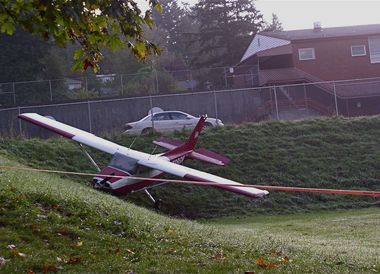-
Practicing the ABCs of Emergency Procedures

 I was not sure how my flight was going to go yesterday after not flying for six days, but I have to say that I was pretty damn proud of myself. After my flight last Wednesday I wasn’t too happy with my progress, however yesterday’s flight proved me wrong as I did some great landings (though they still need a bit of cleanup).
I was not sure how my flight was going to go yesterday after not flying for six days, but I have to say that I was pretty damn proud of myself. After my flight last Wednesday I wasn’t too happy with my progress, however yesterday’s flight proved me wrong as I did some great landings (though they still need a bit of cleanup). I began flying again with James and the flight was pretty short and sweet. We ran through three landings over at Aurora State Airport (UAO), played around with some rudder controls, and then practiced an emergency procedure (killing the engine in the air).
I began flying again with James and the flight was pretty short and sweet. We ran through three landings over at Aurora State Airport (UAO), played around with some rudder controls, and then practiced an emergency procedure (killing the engine in the air).The landings all went pretty smoothly though I am going to practice landing a little faster with full flaps today (yes, I am flying again today :))
I also feel a lot more confident in controlling the plane with the rudders. I was struggling with this last week, but feel much better about it after giving it some time to sink in. James had me turn the plane for a while without the use of the ailerons and instead just using the throttle and the rudders. That’ll take more practice though it will definitely engrave into my head the use of the rudders and the throttle.
We followed this by getting into some emergency procedures practicing what to do when the engine goes out and an emergency landing needs to happen. I felt pretty great about it yesterday though I need to continue and memorize the ABCs of an emergency procedure. Those are:
A. Airspeed – best glide speed VG (around 68 knots)
B. Best Place to Land – Find an airport, road, or field to land
C. Checklists – Try to get the plane going again using the emergency checklists
D. Discuss – Tell the passengers what is going on and make all radio calls (mayday, mayday, mayday…)
E. Exit – Get the plane ready to be exited when landing by cracking doorsThese aren’t necessarily what James taught me, but they’re what I remember off the top of my head 🙂
Speaking of emergency landings, just the other day there was an emergency landing where the pilot landed in a middle school field. Pretty awesome stuff.
 After this we went back to Twin Oaks and though my pattern was okay, I was way too high with only 20 degrees of flaps to get down to the runway. I had to do a turn out and try again. The second attempt was much better. I landed, we cleaned up, and went home.
After this we went back to Twin Oaks and though my pattern was okay, I was way too high with only 20 degrees of flaps to get down to the runway. I had to do a turn out and try again. The second attempt was much better. I landed, we cleaned up, and went home.Logs
Flight Time: 1.3 Hours
Landings: 5Related
October 13, 2010 / Jason / Comments Off on Practicing the ABCs of Emergency Procedures
Categories: Private Pilot Completion
Tags: Cessna 172, emergency procedures, flying, James, K7S3, KUAO, N2108Y, Training
Logbook
- Total Flight Time: 318.5 Hours
- Pilot In Command Time: 224.7 Hours
- Solo Time: 300.6 Hours
- >50NM Cross Country Time: 95.2 Hours
- >50NM Cross Country Time (Solo): 62.5 Hours
- Night Time: 8.5 Hours
- Simulated Instrument Time: 4.8 Hours
- Landings (Day/Night): 617 (593/24)
- Flight Training Received: 92.8 Hours
- Ground Training Received: 30.8 Hours
Updated 5/2/2019
Comments are currently closed.